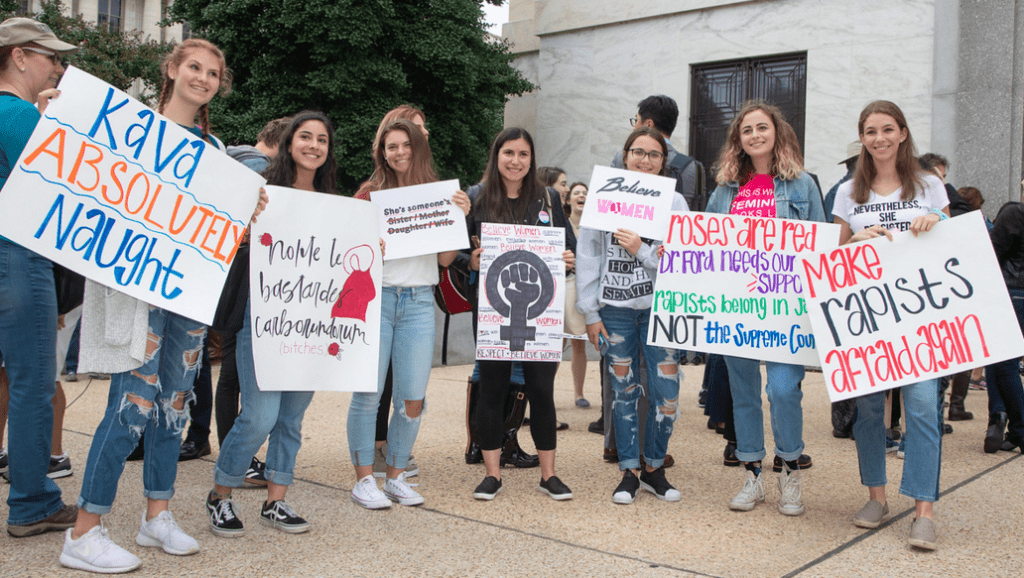Senate Sexual Assault Hearing Is No Circus
By • September 27, 2018 0 455

“I came because I want to support her,” said Laura Zam of Dupont Circle, as she stood patiently in line outside of Room 538 in the Dirksen Senate Office Building, being used as overflow seating for the Sept. 27 Senate Judiciary Committee hearing on the alleged sexual assault of Christine Blasey Ford by Supreme Court nominee Brett Kavanaugh when both were teenagers, more than 30 years ago. “I want to stand up to the power of the old men on the committee who don’t understand sexual trauma women have undergone.”
She probably was not going to get into the overflow room. People in front of her had already been waiting for hours. When one finally got in, everyone in line cheered and clapped, and she hugged all her friends and fans before entering. But that wasn’t Zam.
Zam stood at the end of the line with others who quietly waved signs declaring “Dems and Repubs are Sexually Assaulted” and wore shirts printed with “I am a survivor and I vote” and pins saying: “Save Roe, Stop Kavanaugh.”
Certainly Zam and everyone else were not going to get into the hearing room itself, held not in the usual grand-salle of the Hart Office Building but in the smaller 226 DSOB room on the second floor, usually reserved for Judiciary subcommittee events. But Zam, like dozens of print, TV and radio journalists — many from major publications and media outlets — were willing to wait out in the halls behind a rope, quietly talking to each other and gathering around mobile phones and iPads to watch the goings on.
Inside the room, the configuration had been changed slightly. The witness table was positioned close to the ends of the curved table for Senate members. A tall table was set in front of the Republican senators for their surrogate prosecutor.
Outside the hearing room, the large number of Capitol police officers stationed in groups up and down the halls was unusual and a bit unnerving. They blocked off elevators, doors and entrances to the Dirksen building from all approaches, checking credentials studiously and monitoring rope lines assiduously. Security guards at the entrance to Dirksen even ordered some of those entering to take off their shoes.
What was absent was the almost circus-like atmosphere of costumes, chanters and directed protests that marked many other contentious hearings at Dirksen. The several hundred protestors and counterprotestors who had gathered outside the DSOB early in the morning, and were relatively calm according to one Capitol police officer, had all but disappeared by midmorning. A steady rain dampened a planned protest in front of the Supreme Court around 1 p.m.; protests under a roof of umbrellas were muffled. And there was no rage.
Mostly the crowds were made up of women, middle-aged and neatly dressed. Many, like Zam, identified themselves as survivors of sexual assault. “I don’t believe everything I hear at all, but I believe Professor Ford,” she said. “It all rang very true to me.”
That is the question that still hung in the air at press time at 3 p.m. Unlike many other controversial hearings, the atmosphere surrounding this one among the press and the supporters waiting in line and outside was intentionally rumpus-free. “We need her to feel comfortable,” some women from Baltimore put it.
Inside, the same dictum seemed to be in place as Ford was questioned and she answered, often with a trembling voice. “Take your time,” Ford was continually advised by both Committee Chair Chuck Grassley (R-Iowa) and ranking member Diane Feinstein (D-California). Her titles professor or doctor were always used. “The witness appears tired. We’ll take a 45-minute break,” Grassley decided at 2:30 p.m.
But, by press time, the atmosphere outside and in the hearing room changed once Judge Kavanaugh began to testify. Indignant, at times red with anger and at times choking back tears, he declared his life had been “totally and permanently destroyed” by accusations of sexual assault that he fervently claimed were untrue. Journalists in the Senate gallery who during Ford’s testimony were quiet to the point of reverence, at first broke out in laughs of disbelief and sardonic remarks. But as Kavanaugh continued, the faces of the Senate panel became grim and the press gallery became silent.
Which witness was more credible? What if it’s a draw? Will the decision in the end be driven only by partisanship and politics? The Senate has never seen anything quite like this hearing.

